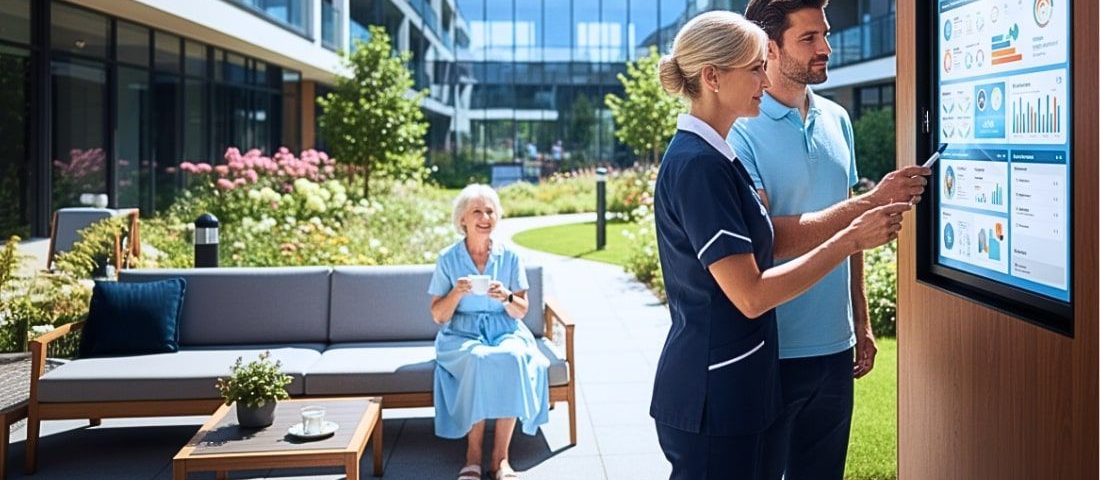Technology in senior living management is no longer optional. Providers who use digital tools improve care and operations. Senior living operators, investors, and facility leaders face rising costs, staffing shortages, and growing resident expectations. They need reliable tools to stay competitive.
This post shows specific ways technology delivers value in care, safety, resident experience, staff support, and efficiency.
Driving Change with Technology in Senior Living Management
Smart Environment & Access Control
Communities are upgrading from manual keys to mobile credentials, video intercoms, and cloud-based access systems. Keyless entry, motion sensors, and occupancy-based lighting improve security while reducing manual work.
Building automation now regulates HVAC, air quality, and lighting to enhance comfort and cut energy costs. Smart thermostats and leak detection sensors also help reduce maintenance issues before they escalate. Many operators have seen shorter maintenance cycles and measurable energy savings from these systems.
Predictive Analytics & AI Decision Support
Artificial intelligence helps teams detect issues before they become emergencies. Predictive models use resident data, wearables, and behavioral trends to flag fall risks or cognitive decline.
Some operators employ predictive dashboards and electronic health record (EHR) integrations to identify residents who may need early intervention. AI platforms can summarize clinical notes, surface care priorities, and send real-time alerts.
These systems help managers allocate staff time more efficiently and focus on prevention rather than reaction.
Remote Monitoring, Telehealth & Wearables
Remote patient monitoring and telehealth are now essential in senior care. Wearables such as smartwatches and Bluetooth-enabled blood pressure monitors transmit real-time data to staff. Motion sensors and ambient monitoring systems track movement patterns and detect anomalies, such as prolonged inactivity or wandering. Telehealth platforms allow residents to consult physicians remotely, reducing travel and appointment delays.
Communities that use these tools report faster response times, fewer hospital visits, and higher family satisfaction.
Resident Engagement & Social Connectivity
Resident engagement technology is redefining connection and community. Digital portals and touchscreen kiosks keep residents informed about daily activities and announcements.
Voice-activated assistants like Alexa or Google Home support reminders, medication cues, and calls without the need for complex devices. Communities also use apps for virtual classes, fitness sessions, and cognitive games that stimulate memory and encourage social interaction.
Residents who use these tools often report greater confidence and belonging.
Workflow, Compliance & Staff Tools
Digital workflows and compliance software improve consistency across every department. Electronic medication administration records (eMAR), task management platforms, and compliance dashboards reduce human error and streamline reporting. Smart scheduling systems balance shifts to prevent staff fatigue and burnout.
Many operators now use mobile communication apps that connect caregivers and administrators instantly, improving accountability and coordination. As repetitive paperwork becomes automated, staff gain more time for meaningful resident engagement.
Measurable Results & ROI Examples
Technology produces measurable operational and clinical improvements. Communities that introduced AI-based fall detection systems have seen significant reductions in time on the ground. Energy automation and digital documentation save thousands of staff hours each year.
Operators who invest in resident connectivity also align with market expectations, as most adults over fifty use digital tools daily. Many senior living companies are now increasing their technology budgets to improve both performance and satisfaction.
Key Questions About Technology in Senior Living
How fast do operators see ROI from tech adoption?
Many communities see measurable results within 12 to 24 months, including fewer incidents, lower operating costs, and improved staff efficiency.
How can technology improve staff recruitment and retention?
Smart scheduling and communication tools help manage workloads and reduce stress. These systems build a more positive work environment and lower turnover.
How does technology affect family involvement in resident care?
Family portals and secure messaging tools keep loved ones informed in real time. This transparency builds trust and strengthens relationships between families and operators.
Which emerging technologies will shape senior living in the next five years?
Expect AI-powered analytics, voice-integrated systems, and connected building platforms to create safer, more personalized, and more efficient communities.
Can residents adapt easily to new tech?
With training and intuitive design, most residents adapt well. Voice and visual feedback make learning simple, even for those less familiar with technology.
How do you ensure data security and compliance?
Choose vendors that meet privacy and regulatory standards. Features such as encryption, access control, and compliance dashboards help protect sensitive information.
Is AI a risk if it replaces staff roles?
AI supports staff; it does not replace them. The goal is to reduce repetitive work and enhance decision-making so employees can focus on quality care.
Empower Your Communities with Canopy Senior Living
At Canopy Senior Living, we help operators use technology to build safer, smarter, and more efficient communities. Our approach blends hands-on operational expertise with data-driven insight, helping communities thrive in a changing market.
Partner with our team to see how technology can elevate your operations and support long-term success for your community. Contact us today!

